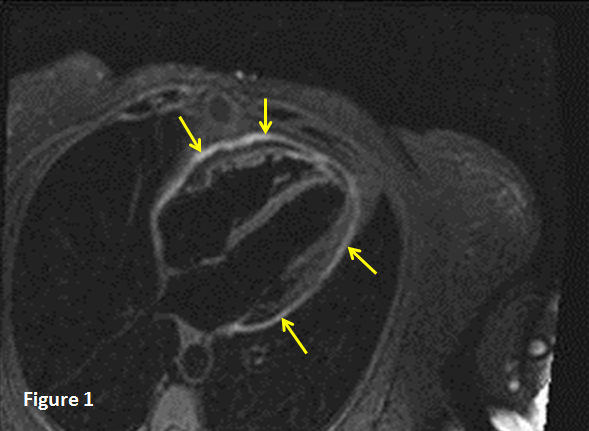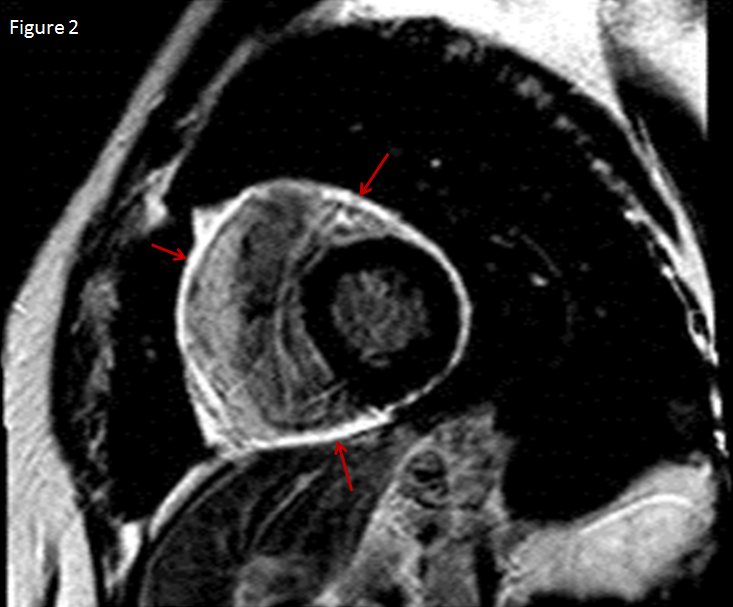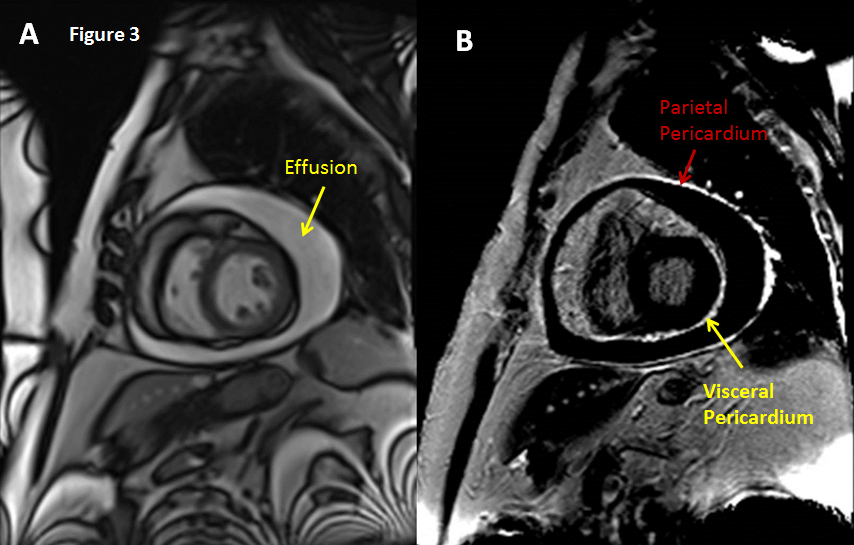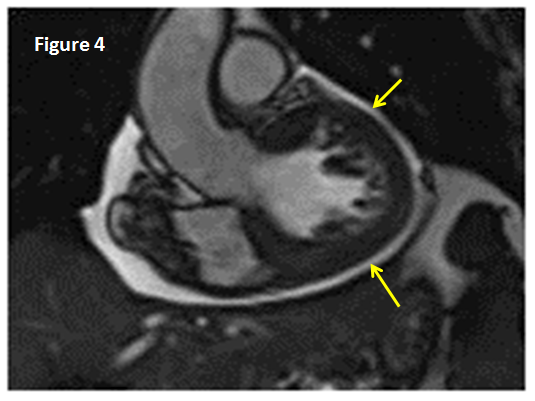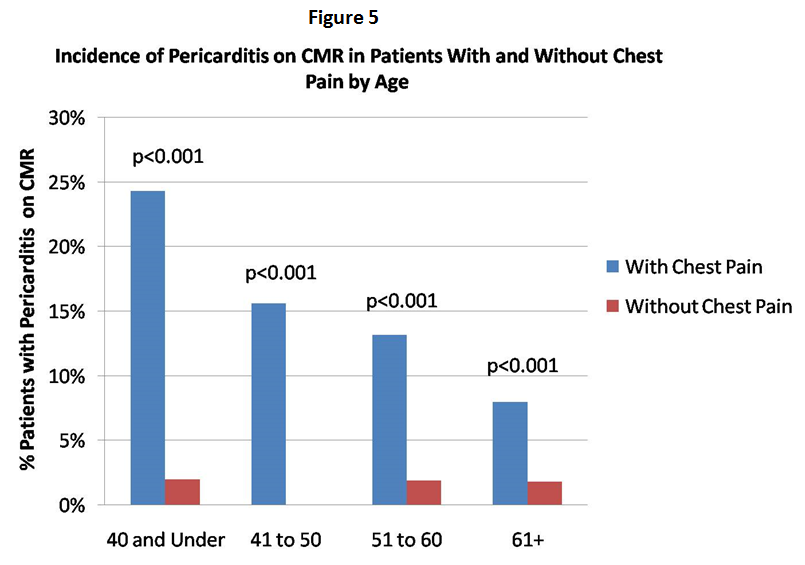New Diagnostic Criteria for Acute Pericarditis: A Cardiac MRI Perspective
Currently, the diagnosis of acute pericarditis is based on demonstrating at least two of the following four criteria: 1. Non-ischemic chest pain, 2. ECG evidence of PR depression or ST segment deviation, 3. Detection of a pericardial rub on auscultation and 4. Pericardial effusion on 2-D echocardiography.1 It is well known that ECG evidence is often lacking and that a pericardial rub is often fleeting and not easily detected. 2-D echocardiography is capable of detecting moderate and large pericardial effusions, but small or very small effusions are difficult to see, especially when image quality is compromised by a narrow intercostal echo window, chronic lung disease or obesity. From a practical standpoint, the only reliable criterion is symptomatic chest pain, often making the diagnosis difficult to definitively establish. The chest pain of pericarditis can vary from severe substernal discomfort to a vague "ache". The chest pain is usually positional, not related to exertion and often radiates to the neck, ridge of the trapezius muscle or shoulder. As an ancillary diagnostic tool, laboratory confirmation of an inflammatory process, such as an elevated sed rate, is sometimes used to support the diagnosis of acute pericarditis, but is non-specific.
With most inflammatory disorders, accumulation of interstitial water is a component of the pathologic process. Magnetic resonance imaging (MRI) is ideally suited for the detecting the exact anatomic location of non-physiologic water, including edema. With T2 weighted cardiac MRI pulse sequences, water appears "bright" and is easily detected, given the excellent spatial resolution of MRI (see Figure 1). T2 weighted imaging does not require contrast injection. However, use of gadolinium contrast with delayed enhancement imaging offers an additional method of detecting abnormal redistribution of water into the pericardial interstitium (see Figure 2). Both Figures 1 and 2 are examples of pericarditis without associated pericardial effusion. A more "classic" example of pericarditis with effusion is shown in Figure 3.
Data presented at the 2014 American College of Cardiology Annual Scientific Session2 attempted to systematically study a series of chest pain patients for evaluation of pericarditis by cardiac MRI using T2 weighted and late gadolinium imaging sequences. Of 44 patients with CMR documented pericarditis, only 5 (11.3%) had a pericardial effusion on their 2-D echo study. Only 22 patients (50%) had a pericardial rub, while only 24 (54.5%) had ECG changes suggestive of pericarditis. Overall, 18 of 44 patients (41%) would not have met current criteria for a diagnosis of pericarditis, if not for CMR findings. Furthermore, 66% of these patients with CMR documented pericarditis had a small pericardial effusion on their CMR study, which was missed on a 2-D echo study (see Figure 4). These data suggest that a substantial portion of patients with chest pain have pericarditis detectable by CMR imaging, but not by currently accepted diagnostic criteria.
Boniface et al 3 presented data at the 2014 American Heart Association Scientific Sessions on CMR evaluation of 708 patients with chest pain who had a negative ischemic evaluation, but complained of persistent chest discomfort and were labeled as non-cardiac chest pain. Cardiac MRI of these patients revealed that 143 of 708 (20.2%) had evidence of pericarditis, undetected by standard diagnostic criteria. These data suggest that 1 out 5 patients with recurrent chest pain and a negative ischemic evaluation may actually have pericarditis. More recent data from Morgenstern et al 4 showed that that the likelihood of detecting pericarditis with CMR in patients with chest pain was highest among patients under age 40, and much less likely in patients over age 60 (see Figure 5).
Although cardiac MRI appears to be useful in detecting pericardial inflammation, the imaging studies have not had direct confirmation with histologic data. Since pericarditis is usually not associated with mortality, autopsy correlation with pre-mortem MRI imaging is non-existent. However, indirect validity is suggested by data from our institution2 which showed that the colchicine-NSAID therapeutic regimen, demonstrated to be effective by Imazio et al 5, was similarly effective when pericarditis was diagnosed with cardiac MRI. However, the study was small and will require validation with larger trials. Until cardiac MRI detection is fully validated, the practical value of cardiac MRI imaging in patients with suspected pericarditis is its ability to detect pericardial effusion, which is often missed with trans-thoracic 2-D echocardiography. Cardiac MRI is also clinically useful for patients with recurrent chest pain after a negative ischemic evaluation. These patients are often very frustrated when a cause for their chest discomfort cannot be definitively identified, even with an extensive "non-cardiac" diagnostic evaluation. Many of these patients, on the verge of being labeled with a psychogenic etiology, are extremely grateful when their pericarditis is detected with cardiac MRI, opening the door for effective therapy and most importantly, relief of their persistent symptoms.
As cardiac MRI imaging criteria for pericarditis develop, further studies will be required to determine if abnormal T2 weighted imaging and abnormal delayed enhancement imaging findings are both required to establish the diagnosis. Would evidence from just one of the CMR imaging pulse sequences suffice or are both necessary? As T1 and T2 mapping capability becomes more widely available, further insight into CMR imaging for pericardial disease is likely to follow. This issue is further compounded by the fact that CMR imaging is not widely used in the United States, as it is usually available only at specialized referral centers and regarded as an expensive research tool by many practicing physicians. CMR imaging of pericarditis with T2 weighted pulse sequences is easy, requires no contrast and takes less than five minutes to perform, yielding valuable diagnostic information especially when the patient is known to have a recent negative ischemic evaluation. A CMR study could be quickly and easily done while a patient is in the Emergency Department, and potentially save an unnecessary admission for recurrent chest pain. Likewise, a CMR study to exclude pericarditis after a negative "observation" admission for chest pain could save repeat visits to the ED. Use of cardiac MRI for detection of pericarditis also has cost saving implications. In the author's geographic area, the cost to the healthcare system (i.e. actual reimbursement) of a cardiac MRI study is $496.20, while that of a visit to the Emergency Department is $1,013.84, a difference of 200%.
In summary, on the basis of these recent data, the following groups of patients seem most likely to benefit from cardiac MRI imaging for pericarditis:
- Patients with persistent chest pain after a negative ischemic evaluation.
- Patients with non-ischemic chest pain suspicious for pericarditis, but no detectable effusion on 2-D echocardiography.
- Patients with non-ischemic chest pain suspicious for pericarditis, but a poor quality or non-diagnostic 2-D echo study.
- Patients with recurrent chest pain after a negative ischemic evaluation and a negative "non-cardiac" chest pain evaluation.
- Younger patients with atypical chest discomfort and a low likelihood of coronary atherosclerotic disease.
Since the advent of cardiac MRI's capability to actually visualize pericardial inflammation, consideration of the diagnosis when dealing with a patient complaining of chest pain is now more appropriate. Radiologists often espouse a phrase "you see what you know and you know what you see". Now that we can "see" pericarditis, we will know it better.
DISCLOSURES:
Use of gadolinium for delayed enhancement cardiac MRI imaging is considered an "off-label" use of this contrast agent.
References
- Imazio M. Pericarditis (Beyond the Basics). UpToDate 2013; http://www.uptodate.com/contents/pericarditis-beyond-the-basics
- Mikolich J, Kley J, Boniface N et al. Are new diagnostic criteria for pericarditis needed? J Am Coll Cardiol. 2014;63(12_S).
- Boniface N, Kley J, Lisko J et al. Non-cardiac chest pain: Is it really? Circulation. 2014;130:A12863.
- Morgenstern D, Kley J, Lisko J et al. Chest pain in patients under age 40: Are we getting it right? J Am Coll Cardiol 2015;65(10_S).
- Imazio M, Brucato A, Cemin R et.al. A randomized trial of colchicine for acute pericarditis. N Engl J Med 2013;369:1522-8.
Keywords: American Heart Association, Anti-Inflammatory Agents, Non-Steroidal, Auscultation, Autopsy, Chest Pain, Colchicine, Depression, Echocardiography, Edema, Electrocardiography, Emergency Service, Hospital, Gadolinium, Heart Diseases, Inflammation, Lung Diseases, Magnetic Resonance Imaging, Obesity, Pericardial Effusion, Pericarditis, Pericardium, Physical Exertion, Shoulder, Superficial Back Muscles
< Back to Listings

